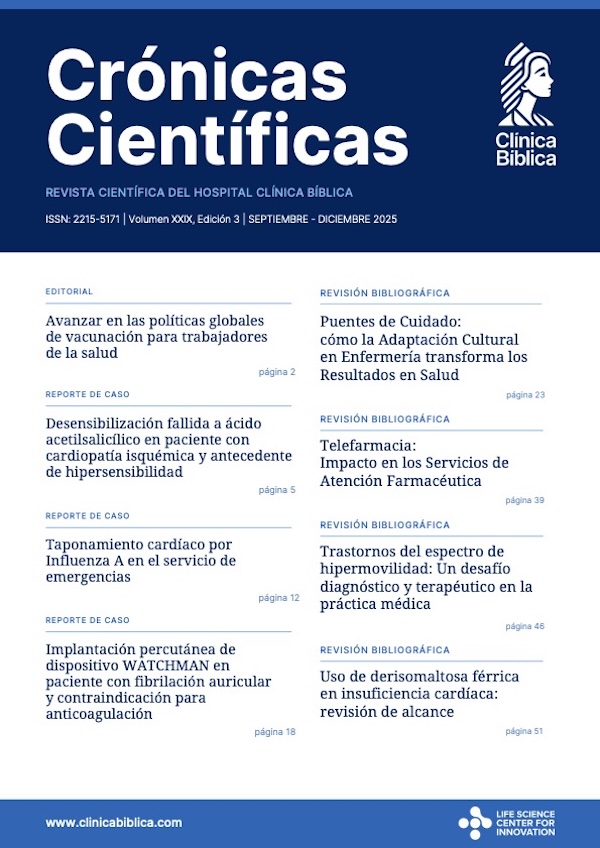- Visto: 1124
Revisión bibliográfica
Efectividad y Seguridad de nuevos anticoagulantes orales utilizados para la prevención del accidente cerebrovascular isquémico en pacientes diagnosticados con fibrilación atrial no valvular
Effectiveness and safety of new oral anticoagulants used for prevention of ischemic stroke in patients diagnosed with non-valvular atrial fibrillation
DOI: https://doi.org/10.55139/GWHN2158
APA (7ª edición)
Betrano, F., Chaverri Fernández, J. M., Miranda, K., Ortiz Ureña, A., Rivera, A., & Zavaleta Monestel, E. (2015). Efectividad y seguridad de nuevos anticoagulantes orales utilizados para la prevención del accidente cerebrovascular isquémico en pacientes con fibrilación atrial no valvular. Crónicas científicas, 1(1), 6-18. https://doi.org/10.55139/GWHN215
Vancouver
Betrano F, Chaverri Fernández JM, Miranda K, Ortiz Ureña A, Rivera A, Zavaleta Monestel E. Efectividad y seguridad de nuevos anticoagulantes orales utilizados para la prevención del accidente cerebrovascular isquémico en pacientes con fibrilación atrial no valvular. Cron. cient. 2015;1(1):6-18. Disponible en: https://doi.org/10.55139/GWHN2158
Fiorella Betrano
Estudiante de internado en Farmacia, Universidad de Costa Rica.
Costa Rica.
Dr. José Miguel Chaverri Fernández
Profesor asociado del Departamento de Farmacología, Toxicología y Farmacodependencia de la Facultad de Farmacia de la Universidad de Costa Rica y farmacéutico del Hospital Clínica Bíblica.
Miembro del Colegio de Farmacéuticos de Costa Rica.
Costa Rica.
Kimberlyn Miranda
Estudiante de internado en Farmacia, Universidad de Costa Rica.
Costa Rica.
Dra. Angie Ortíz Ureña
Profesora del Departamento de Farmacología, Toxicología y Farmacodependencia de la Facultad de Farmacia de la Universidad de Costa Rica.
Miembro del Colegio de Farmacéuticos de Costa Rica.
Costa Rica.
Alma Rivera
Estudiante de internado en Farmacia, Universidad de Costa Rica.
Costa Rica.
Dr. Esteban Zavaleta Monestel
Director de la Farmacia Hospital Clínica Bíblica, Costa Rica.
Miembro del Colegio de Farmacéuticos de Costa Rica.
Costa Rica.
Resumen
Los accidentes cerebrovasculares (ACV) generan gran cantidad de muertes y discapacidades a nivel mundial, y una de sus principales causas es la fibrilación atrial no valvular. Actualmente se cuenta con terapias tradicionales como la aspirina, ya sea sola o en combinación con clopidogrel y warfarina, las cuales han demostrado ser efectivas; pero presentan diversas limitantes, razón por la cual se han desarrollado nuevas alternativas que buscan eliminar y reducir dicha problemática y mejorar su efectividad. Estos medicamentos son conocidos como “nuevos anticoagulantes orales” (NOACs, por sus siglas en inglés) y se clasifican en dos grupos: los inhibidores directos de la trombina (dabigatrán) y los inhibidores del factor X activado (edoxabán, rivaroxabán y apixabán).
Si bien con el análisis de los estudios clínicos respectivos para cada uno de los NOACs se obtienen ciertas conclusiones, no es posible establecer cuál es el anticoagulante ideal; por tanto, el presente estudio busca suministrar al tratante herramientas que le permitan tomar una decisión, basada en la evidencia, con respecto a posibles diferencias, beneficios y perjuicios que se podrían suscitar, ya sea con el estándar (warfarina) o con los otros NOACs, esto ante la ausencia de estudios clínicos que comparen dichos medicamentos entre sí
Palabras claves
Accidente cerebrovascular, anticoagulantes orales, fibrilación atrial no valvular, warfarina.
Abstract
Stroke generates a large number of deaths and disabilities worldwide; one of its main causes being nonvalvular atrial fibrillation. Current traditional therapies such as aspirin, either alone or in combination with clopidogrel, and warfarin, have proved to be effective for prevention of ischemic stroke; nevertheless, these medications have several limitations. New alternatives that strive not only to eliminate or reduce these limitations but to improve their effectiveness as prophylactic treatment of ischemic stroke in patients with non-valvular atrial fibrillation have been developed. These drugs are known as “new oral anticoagulants” (NOACs) and are classified into two groups: direct thrombin inhibitors (dabigatrán) and factor Xa inhibitors (edoxabán, rivaroxabán and apixabán).
Certain conclusions could be obtained with the analysis of the respective clinical studies for each NOAC. We have dedicated this literature review to analyze the different clinical evidence regarding NOACs for stroke prevention. This work would bring tools for physicians, based on published clinical evidence regarding possible differences, benefits and damages that could arise, either from standard medication (warfarin) or other NOACs, all of this in the absence of clinical studies comparing these drugs and its effects.
Keywords
Stroke, oral anticoagulants, non-valvular atrial fibrillation, warfarin .
Bibliografía
1. OMS. Accidente cerebrovascular. Recuperado el 25 de marzo del 2014, de https://apps.who.int/infobase/
2. Van der Worp B, Gijn J. Acute ischemic stroke. N Engl J Med. 2007; 357:572-579.
3. Davis SM, Donnan GA. Secondary prevention after ischemic stroke or transient ischemic attack. N Engl J Med. 2012; 366:1914-1922.
4. Avezum Á, Cantú C, True M, Lobban T, Massaro A, Meschengieser S, et al. ¿Cómo reducir los accidentes cerebrovasculares en Latinoamérica ? 95 páginas. Recuperado el 24 de marzo del 2014, de: http://www.fmed.uba.ar/taquini/Prevencion%20del%20ACV.pdf
5. Singer DE, Albers GW, Dalen JE, Go AS, Halperin JL, Manning WJ. Antithrombotic therapy in atrial fibrillation: the Seventh ACCP Conference on Antithrombotic and Thrombolytic Therapy. Chest. 2004; 126(3 Suppl):429S–456S
6. Rozenman Y, Gluzman Y. Atrial Fibrillation Therapy. En: Dan G-A, Bayés de Luna A, Camm J. Editorial Springer. 2014.
7. You J, Singer D, Howard P, Lane D, Eckman M, Fang M, et al. Antithrombotic Therapy and Prevention of Thrombosis: American College of Chest Physicians Evidence-Based Clinical Practice Guidelines, 9th ed. Chest. 2012, 141: e531S–e575S
8. Furie KL, Goldstein LB, Albers GW, Khatri P, Neyens R, Turakhia MP, et al. Oral antithrombotic agents for the prevention of stroke in non valvular atrial fibrillation: a science advisory for healthcare professionals from the American Heart Association/American Stroke Association. American Heart Association/American Stroke Association. 2012; 43:3442–53
9. Thomas G, Lerman BB. Prediction of stroke risk in atrial fibrillation, prevention of stroke in atrial fibrillation, and the impact of long-term monitoring for detecting atrial fibrillation. Current atherosclerosis reports. 2011; 13(4):290–7
10. Odum LE, Cochran KA, Aistrope DS, Snella KA. The CHADS2 versus the new CHA2DS2-VASc scoring systems for guiding antithrombotic treatment of patients with atrial fibrillation: review of the literature and recommendations for use. Pharmacotherapy. 2012; 32(3):285–96
11. Schulman S, Kearon C. Definition of major bleeding in clinical investigations of antihemostatic medicinal products in non-surgical patients. J thromb haemost. 2005; 3: 692–694
12. Connolly SJ, Pogue J, Hart RG, Hohnloser SH, Pfeffer M, Chrolavicius S, Yusuf S. The ACTIVE investigators effect of clopidogrel added to aspirin in patients with atrial fibrillation. N Engl J Med. 2009; 360:2066-2078
13. Rozenman Y, Gluzman Y. Atrial fibrillation therapy. En: Dan G-A, Bayés de Luna A, Camm J, ed. Current Cardiovascular Therapy. London: Springer London, 2014: 55–89
14. Granger C, Alexander J, McMurray J, Lopes R, Hylek E, Hanna M, et al. Apixaban versus Warfarin in Patients with Atrial Fibrillation. N Engl J Med. 2011;365 (11):981-992.
15. Giugliano R, Ruff C, Braunwald E, Murphy S, Wiviott S, Halperin J, et al. Edoxaban versus Warfarin in Patients with Atrial Fibrillation. N Engl J Med. 2013; 369 (22): 2093-2104
16. Connolly S, Ezekowitz M, Yusuf S, Eikelboom J, Oldgren J, Parekh A, et al. Dabigatran versus Warfarin in Patients with Atrial Fibrillation. N Engl J Med. 2009;361 (12):1139-1151
17. Patel M, Mahaffey K, Garg J, Pan G, Singer D, Hacke W, et al. Rivaroxaban versus Warfarin in Nonvalvular Atrial Fibrillation. N Engl J Med. 2011; 365 (10): 883-891
18. Durham TA, Turner JR. Massachusetts Medical Society New England Journal of Medicine. Recuperado el 21 de marzo del 2014, de: http://www.researchgate.net/journal/0028-4793_New_England_Journal_of_Medicine
19. Christian R, Robert G, Eugene B. Microsoft Academic Research. Recuperado el 15 de abril del 2014, de: http://academic.research.microsoft.com/RankList?entitytype=2&topDomainID=6&subDomainID=3&last=0&start=201&end=300
20. Durham TA, Turner JR. Study design and experimental methodology. Introduction to Statistics in Pharmaceutical Clinical Trials. London: Pharmaceutical Press, 2008. p. 38, 39, 76-79.
21. Altman R, Vidal H. Battle of oral anticoagulants in the field of atrial fibrillation scrutinized from a clinical practice (the real world) perspective. Thrombosis Journal. 2011, 9: 2-8.
22. Christian R, Robert G, Eugene B, Elaine H, Naveen D, Michael E, et al. Comparison of the efficacy and safety of new oral anticoagulants with warfarin in patients with atrial fibrillation: a meta-analysis of randomised trials. The Lancet. 2014; 383 (9921): 955-962
23. Skjøth F, Larsen TB, Rasmussen LH, et al. Efficacy and safety of edoxaban in comparison with dabigatran, rivaroxaban and apixaban for stroke prevention in atrial fibrillation: An indirect comparison analysis. Thromb Haemost .2014; 111:981-988
24. Busko M. Which new oral anticoagulant for stroke prevention in AF? Recuperado el 23 de mayo de: 2014. http://www.medscape.com/viewarticle/825293
APA (7ª edición)
Betrano, F., Chaverri Fernández, J. M., Miranda, K., Ortiz Ureña, A., Rivera, A., & Zavaleta Monestel, E. (2015). Efectividad y seguridad de nuevos anticoagulantes orales utilizados para la prevención del accidente cerebrovascular isquémico en pacientes con fibrilación atrial no valvular. Crónicas científicas, 1(1), 6-18. https://doi.org/10.55139/GWHN215
Vancouver
Betrano F, Chaverri Fernández JM, Miranda K, Ortiz Ureña A, Rivera A, Zavaleta Monestel E. Efectividad y seguridad de nuevos anticoagulantes orales utilizados para la prevención del accidente cerebrovascular isquémico en pacientes con fibrilación atrial no valvular. Cron. cient. 2015;1(1):6-18. Disponible en: https://doi.org/10.55139/GWHN2158
Esta obra está bajo una licencia internacional Creative Commons: Atribución-NoComercial-CompartirIgual 4.0 Internacional (CC BY-NC-SA 4.0)

Realizar búsqueda
Última Edición
Ediciones Anteriores






